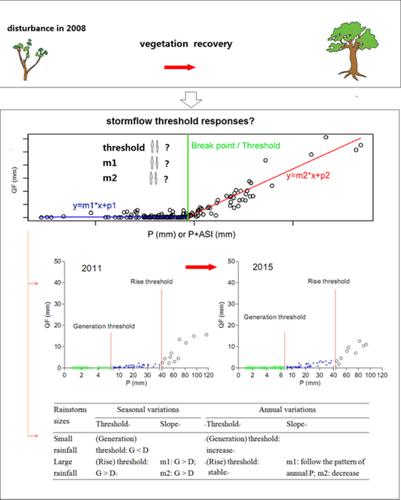当前位置:
X-MOL 学术
›
Hydrol. Process.
›
论文详情
Our official English website, www.x-mol.net, welcomes your
feedback! (Note: you will need to create a separate account there.)
Stormflow threshold behavior in a subtropical mountainous headwater catchment during forest recovery period
Hydrological Processes ( IF 2.8 ) Pub Date : 2020-02-22 , DOI: 10.1002/hyp.13658 Lezhang Wei 1, 2, 3 , Zhijun Qiu 4 , Guangyi Zhou 4 , Tsuyoshi Kinouchi 5 , Yu Liu 1, 2, 3
Hydrological Processes ( IF 2.8 ) Pub Date : 2020-02-22 , DOI: 10.1002/hyp.13658 Lezhang Wei 1, 2, 3 , Zhijun Qiu 4 , Guangyi Zhou 4 , Tsuyoshi Kinouchi 5 , Yu Liu 1, 2, 3
Affiliation

|
Forest ecohydrological feedbacks complicate the threshold behaviour of stormflow response to precipitation or wetting conditions on a long‐term scale (e.g. several years). In this study, the threshold behaviours in an evergreen‐deciduous mixed forested headwater catchment in southern China were examined during 2009–2015, when damaged vegetation was recovering after the great 2008 Chinese ice and snowstorm. The non‐uniqueness of the thresholds and the slow and rapid responses of stormflow at the outlet of the catchment in different hydro‐climate datasets with different maximum values of gross precipitation (P) and sums of precipitation and antecedent soil moisture index (P + ASI) were assessed. The thresholds of P and P + ASI required to trigger stormflows (i.e. ‘generation thresholds’) and the transition from slow to rapid responses of stormflow (i.e. ‘rise thresholds’) were compared both seasonally and annually. The results indicated significant differences in the analysed datasets, highlighting the need to compare thresholds with care to avoid misinterpretation. Seasonal variations in threshold behaviours in the catchment suggested that vegetation canopy interception contributed to higher rise thresholds, and wetter conditions resulted in higher runoff sensitivity to precipitation during the growing and rainy seasons. Furthermore, the generation thresholds were higher in the dormant season, possibly due to drier soil moisture conditions in the near‐channel areas. During the vegetation recovery period, the annual generation thresholds increased, however the rise thresholds did not exhibit a similar trend. The rapid stormflow response above the threshold decreased, possibly due to transpiration and interception of the recovered vegetation. However, the slow stormflow response to small rainfall events below the thresholds was higher in wetter years but lower in drier years, suggesting that the total water input dominated the stormflow response during small rainfall events. In conclusion, the seasonal and annual variations in threshold behaviours highlight that vegetation recovery and hydro‐climatic conditions had a notable impact on the stormflow response.
更新日期:2020-02-22











































 京公网安备 11010802027423号
京公网安备 11010802027423号